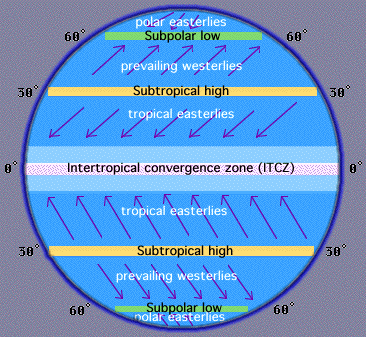Wind Belts
The general wind circulation arises from the differential heating of land and water. This differential heating causes relative high and low pressures. This pressure gradient is the driving force behind winds. The winds are also deflected by a force due to the rotation of the earth. This force is called the Coriolis force. The Coriolis force deflects the wind to the right in the northern hemisphere and to the left in the southern hemisphere.
The wind belts arise from three different three-dimensional wind "cells" that transfer air from the equator to the poles. These cells are called the Hadley cell, the Ferrell cell and the Polar cell. I will describe each of these cells below.
This is the cell that is closest to the equator. It consists of winds converging and rising at the equator and then diverging north and south of the equator as it reaches the upper troposphere. The winds then sink at 30 degrees latitude as they converge with winds in the Ferrell Cell. They hit the surface and diverge back to the equator to complete the cell. This provides the equator-ward wind component of the Trade Winds.
This cell has winds sinking at 30 degrees latitude and then traveling pole-ward as they hit the ground and diverge with winds from the Hadley Cell. This provides the pole-ward component of the mid-latitude westerlies. These winds travel towards the poles until they converge with winds in the polar cell at 60 degrees latitude. These winds then rise up and spread out equator-ward to complete the cell.
This cell has winds rising up at 60 degrees latitude and spreading out pole-ward as they reach the upper troposphere. The winds sink down at the poles and then diverge towards the equator until they reach 60 degrees latitude where they rise up again to complete the cell. They provide the equator-ward component of the Polar Easterlies.
If there was no Coriolis force, the global wind belts at the surface would blow strictly in the north-south direction. The Coriolis force deflects the wind and gives it an east-west component. This can be seen with a simplified model of the global wind belts.

As you can see, there is high pressure at 30 degrees latitude. This is what you would expect, since the air is sinking as the Hadley and Polar cells diverge at this latitude.
The Inter-tropical Convergence Zone (ITCZ) is a major area of low pressure. This again we can expect as air is rising at the equator due to the surface convergence of both Hadley cells. The Subpolar low exists because of the convergence of the Ferrell and Polar cells at the surface causing air to rise up.
This page was last updated: December 11, 2003
created by: cyclonic_vortex@yahoo.com